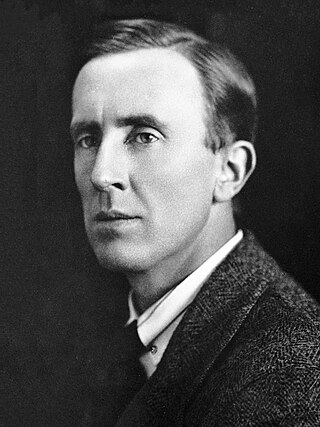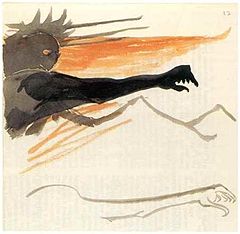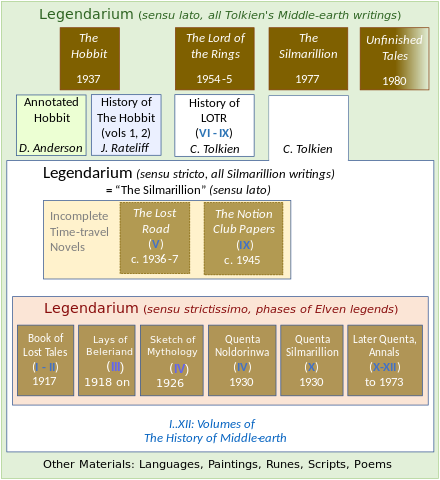
Tom Bombadil is a character in J. R. R. Tolkien's legendarium. He first appeared in print in a 1934 poem called "The Adventures of Tom Bombadil", which also included The Lord of the Rings characters Goldberry, Old Man Willow and the Barrow-wight, from whom he rescues the hobbits. They were not then explicitly part of the older legends that became The Silmarillion, and are not mentioned in The Hobbit.
In the fantasy of J. R. R. Tolkien, the Dwarves are a race inhabiting Middle-earth, the central continent of Arda in an imagined mythological past. They are based on the dwarfs of Germanic myths who were small humanoids that lived in mountains, practising mining, metallurgy, blacksmithing and jewellery. Tolkien described them as tough, warlike, and lovers of stone and craftsmanship.
The "Ainulindalë" is the creation account in J. R. R. Tolkien's legendarium, published posthumously as the first part of The Silmarillion in 1977. The "Ainulindalë" sets out a central part of the cosmology of Tolkien's legendarium, telling how the Ainur, a class of angelic beings, perform a great music prefiguring the creation of the material universe, Eä, including Middle-Earth. The creator Eru Ilúvatar introduces the theme of the sentient races of Elves and Men, not anticipated by the Ainur, and gives physical being to the prefigured universe. Some of the Ainur decide to enter the physical world to prepare for their arrival, becoming the Valar and Maiar.
In J. R. R. Tolkien's Middle-earth, the Eagles or Great Eagles, are immense birds that are sapient and can speak. The Great Eagles resemble actual eagles, but are much larger. Thorondor is said to have been the greatest of all birds, with a wingspan of 30 fathoms. Elsewhere, the Eagles have varied in nature and size both within Tolkien's writings and in later adaptations.
The Notion Club Papers is an abandoned novel by J. R. R. Tolkien, written in 1945 and published posthumously in Sauron Defeated, the 9th volume of The History of Middle-earth. It is a time travel story, written while The Lord of the Rings was being developed. The Notion Club is a fictionalization of Tolkien's own such club, the Inklings. Tolkien's mechanism for the exploration of time is through lucid dreams. These allow club members to experience events as far back as the destruction of the Atlantis-like island of Númenor, as narrated in The Silmarillion.
Ælfwine the mariner is a fictional character found in various early versions of J. R. R. Tolkien's Legendarium. Tolkien envisaged Ælfwine as an Anglo-Saxon who visited and befriended the Elves and acted as the source of later mythology. Thus, in the frame story, Ælfwine is the stated author of the various translations in Old English that appear in the twelve-volume The History of Middle-earth edited by Christopher Tolkien.

The Round World Version is an alternative creation myth to the version of J.R.R. Tolkien's legendarium as it appears in The Silmarillion and The Lord of the Rings. In that version, the Earth was created flat and was changed to round as a cataclysmic event during the Second Age in order to prevent direct access by Men to Valinor, home of the immortals. In the Round World Version, the Earth is created spherical from the beginning.

In J. R. R. Tolkien's legendarium, the history of Arda, also called the history of Middle-earth, began when the Ainur entered Arda, following the creation events in the Ainulindalë and long ages of labour throughout Eä, the fictional universe. Time from that point was measured using Valian Years, though the subsequent history of Arda was divided into three time periods using different years, known as the Years of the Lamps, the Years of the Trees, and the Years of the Sun. A separate, overlapping chronology divides the history into 'Ages of the Children of Ilúvatar'. The first such Age began with the Awakening of the Elves during the Years of the Trees and continued for the first six centuries of the Years of the Sun. All the subsequent Ages took place during the Years of the Sun. Most Middle-earth stories take place in the first three Ages of the Children of Ilúvatar.
The term Middle-earth canon, also called Tolkien's canon, is used for the published writings of J. R. R. Tolkien regarding Middle-earth as a whole. The term is also used in Tolkien fandom to promote, discuss and debate the idea of a consistent fictional canon within a given subset of Tolkien's writings.

Middle-earth is the setting of much of the English writer J. R. R. Tolkien's fantasy. The term is equivalent to the Miðgarðr of Norse mythology and Middangeard in Old English works, including Beowulf. Middle-earth is the human-inhabited world, that is, the central continent of the Earth, in Tolkien's imagined mythological past. Tolkien's most widely read works, The Hobbit and The Lord of the Rings, are set entirely in Middle-earth. "Middle-earth" has also become a short-hand term for Tolkien's legendarium, his large body of fantasy writings, and for the entirety of his fictional world.

Sauron is the title character and the primary antagonist, through the forging of the One Ring, of J. R. R. Tolkien's The Lord of the Rings, where he rules the land of Mordor and has the ambition of ruling the whole of Middle-earth. In the same work, he is identified as the "Necromancer" of Tolkien's earlier novel The Hobbit. The Silmarillion describes him as the chief lieutenant of the first Dark Lord, Morgoth. Tolkien noted that the Ainur, the "angelic" powers of his constructed myth, "were capable of many degrees of error and failing", but by far the worst was "the absolute Satanic rebellion and evil of Morgoth and his satellite Sauron". Sauron appears most often as "the Eye", as if disembodied.

The Silmarillion is a collection of myths and stories in varying styles by the English writer J. R. R. Tolkien. It was edited and published posthumously by his son Christopher Tolkien in 1977, assisted by Guy Gavriel Kay, who became a fantasy author. It tells of Eä, a fictional universe that includes the Blessed Realm of Valinor, the ill-fated region of Beleriand, the island of Númenor, and the continent of Middle-earth, where Tolkien's most popular works—The Hobbit and The Lord of the Rings—are set. After the success of The Hobbit, Tolkien's publisher, Stanley Unwin, requested a sequel, and Tolkien offered a draft of the writings that would later become The Silmarillion. Unwin rejected this proposal, calling the draft obscure and "too Celtic", so Tolkien began working on a new story that eventually became The Lord of the Rings.
Christianity is a central theme in J. R. R. Tolkien's fictional works about Middle-earth, but the specifics are always kept hidden. This allows for the books' meaning to be personally interpreted by the reader, instead of the author detailing a strict, set meaning.

Tolkien's artwork was a key element of his creativity from the time when he began to write fiction. The philologist and author J. R. R. Tolkien prepared a wide variety of materials to support his fiction, including illustrations for his Middle-earth fantasy books, facsimile artefacts, more or less "picturesque" maps, calligraphy, and sketches and paintings from life. Some of his artworks combined several of these elements.
J. R. R. Tolkien built a process of decline and fall in Middle-earth into both The Silmarillion and The Lord of the Rings.
England and Englishness are represented in multiple forms within J. R. R. Tolkien's Middle-earth writings; it appears, more or less thinly disguised, in the form of the Shire and the lands close to it; in kindly characters such as Treebeard, Faramir, and Théoden; in its industrialised state as Isengard and Mordor; and as Anglo-Saxon England in Rohan. Lastly, and most pervasively, Englishness appears in the words and behaviour of the hobbits, both in The Hobbit and in The Lord of the Rings.
Tolkien's monsters are the evil beings, such as Orcs, Trolls, and giant spiders, who oppose and sometimes fight the protagonists in J. R. R. Tolkien's Middle-earth legendarium. Tolkien was an expert on Old English, especially Beowulf, and several of his monsters share aspects of the Beowulf monsters; his Trolls have been likened to Grendel, the Orcs' name harks back to the poem's orcneas, and the dragon Smaug has multiple attributes of the Beowulf dragon. The European medieval tradition of monsters makes them either humanoid but distorted, or like wild beasts, but very large and malevolent; Tolkien follows both traditions, with monsters like Orcs of the first kind and Wargs of the second. Some scholars add Tolkien's immensely powerful Dark Lords Morgoth and Sauron to the list, as monstrous enemies in spirit as well as in body. Scholars have noted that the monsters' evil nature reflects Tolkien's Roman Catholicism, a religion which has a clear conception of good and evil.
J. R. R. Tolkien used frame stories throughout his Middle-earth writings, especially his legendarium, to make the works resemble a genuine mythology written and edited by many hands over a long period of time. He described in detail how his fictional characters wrote their books and transmitted them to others, and showed how later in-universe editors annotated the material.

J. R. R. Tolkien, a devout Roman Catholic, created what he came to feel was a dilemma for himself with his supposedly evil Middle-earth peoples like Orcs, when he made them able to speak, so they were sentient and sapient, and portrayed them talking about right and wrong. This meant, he believed, that they were open to morality, like Men. In Tolkien's Christian framework, that in turn meant they must have souls, so killing them would be wrong without very good reason. Orcs serve as the principal forces of the enemy in The Lord of the Rings, where they are slaughtered in large numbers in the battles of Helm's Deep and the Pelennor Fields in particular.
In Tolkien's legendarium, ancestry provides a guide to character. The apparently genteel Hobbits of the Baggins family turn out to be worthy protagonists of The Hobbit and The Lord of the Rings. Bilbo Baggins is seen from his family tree to be both a Baggins and an adventurous Took. Similarly, Frodo Baggins has some relatively outlandish Brandybuck blood. Among the Elves of Middle-earth, as described in The Silmarillion, the highest are the peaceful Vanyar, whose ancestors conformed most closely to the divine will, migrating to Aman and seeing the light of the Two Trees of Valinor; the lowest are the mutable Teleri; and in between are the conflicted Noldor. Scholars have analysed the impact of ancestry on Elves such as the creative but headstrong Fëanor, who makes the Silmarils. Among Men, Aragorn, hero of The Lord of the Rings, is shown by his descent from Kings, Elves, and an immortal Maia to be of royal blood, destined to be the true King who will restore his people. Scholars have commented that in this way, Tolkien was presenting a view of character from Norse mythology, and an Anglo-Saxon view of kingship, though others have called his implied views racist.










